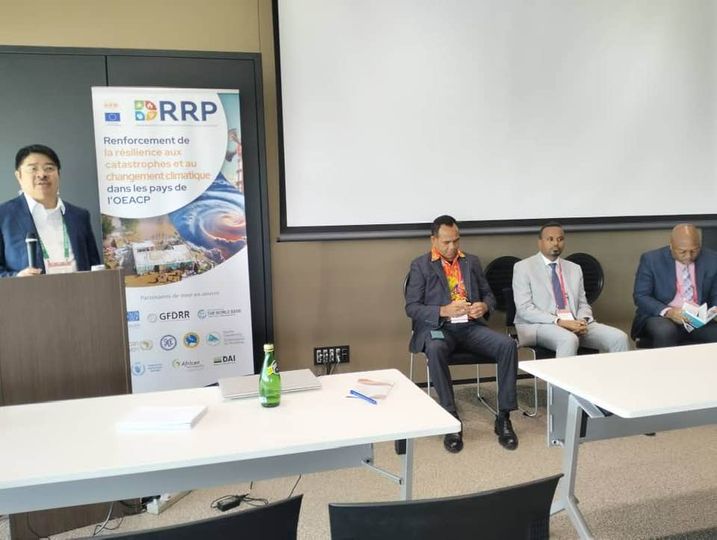Presidente Autoridade Protesaun Sivil, Sup. Polisia Ismael da Costa Babo, representa Governo Timor-Leste hanesan Panalista ho tópiku Risk Governance iha UR-24 Global Forum, Himeji-japan.
Focus Day on Innovative Risk Reduction and Recovery Solutions for ACP Countries
(21 June, Friday, Session)
Mr. Sanny Ramos Jegillo, Senior Adviser-Team Leader, Recovery and Resilience Building Team within the Crisis Bureau at the UNDP,
Mr. Francis Fontenelle, Permanent Secretary, Ministry of Finance, Economic Development and the Youth Economy, Saint Lucia,
Mr. Abdullahi Ali Watiin, Mayor of Baidoa, Somalia,
Ladies and Gentlemen,
Good afternoon. Thank you very much for giving me, on behalf of the Civil Protection Authority (CPA) of Timor-Leste, the opportunity to share our perspective and experience on Risk Governance.
- Timor Leste is a Small Island Developing State (SIDS) and one of the world’s youngest countries. It is in Southeast Asia. It grapples with preexisting vulnerabilities and the threat of geophysical and hydrometeorological hazards, which are exacerbated by climate change. These unique circumstances necessitate a robust and adaptive approach to disaster risk management.
- While our country is still addressing development issues, we are now investing in disaster risk management as our priority to address the impacts of natural hazard disasters. In 2020, the legal basis and organic law for civil protection in Timor-Leste were approved. The law mandated the Civil Protection Authority (CPA) as the government agency responsible for disaster risk reduction (DRR) and disaster risk management (DRM).
- As a recently established authority, the Civil Protection Authority (CPA) of Timor-Leste has made significant strides in a short period. Despite the challenges posed by limited resources and many hard-to-reach villages, particularly during disasters, the CPA has managed to deliver key achievements within less than 2 years since its establishment on 29 June 2022.
- In 2023, we developed our National Civil Protection Emergency Plan (NCPEP), outlining a whole-government approach to respond to disasters. This plan also outlines how we conduct risk governance that determines the scale and necessary actions to respond to disaster. The plan is complemented by a set of Annexes, one of which is a comprehensive Rapid Assessment template. These templates help us collect risk and impact data, which will support us in making decisions on determining activation levels and type of emergency declaration (Level 1, 2, and 3 or what we call global response). Upon data and information collection, as part of the NCPEP Annexes, we have templates for disseminating information to the public and the Government. Recently, we have had new partnerships with telecommunication providers to help us broadcast messages for early warning to communities.
- CPA houses the National Operations Command for Civil Protection (or what we call CNOPS), which is the heart of our operations for monitoring risk, disseminating information, and responding to disasters. The operation room is equipped with Disaster AWARE, supported by the Pacific Disaster Centre (PDC), Tsunami Service Provider (TSP), Indian Ocean Tsunami Early Warning and Mitigation System (IOTEWMS), National Data Centre (CTBTO/NDC), and other several weather and geology forecast sources, such as from Indonesian- BMKG and Australia-Biro of Metrology. The operation room also houses a 24/7-hour single emergency number that can be accessible for the municipalities and community to report incidents to the National CPA. During emergencies, we also use this telephone, radio, and other telecommunication equipment to reach out to municipalities.
- Following the report on the incident, we conduct an assessment using the comprehensive rapid assessment templates and Timor Emergency Response System as our data collection tools. The rapid assessment template has mainstreamed segregated SAGAGREDET data to cover the impact and needs of vulnerable groups, such as women, children, and disabled communities, as well as a sectoral approach. The templates are part of the National Civil Protection Emergency Plan (NCPEP) Annexes. The set of questions in the rapid assessment template has been digitalized into TERS for easier use for the team in the field. TERS is like Kobotoolbox, a data collection tool that can be used offline. The difference with Kobotoolbox is that TERS does not require a regular subscription fee, which may be challenging for a newly established agency like CPA to sustain the funding for the tool.
- While we have our vision but need more funding and human resource capacities, these milestones are made possible because we have strong support from our in-country, international development, and humanitarian partners. We have good partnerships and coordination with global and local partners, such as the UN agencies in Particularly with UNDP (multi-hazard risk mapping and early warning system), FAO (Anticipatory Action Roadmap on Disaster), WFP (mobile and reposition of emergency warehouse), UNDRR (Mid-Term Review For Sendai Framework) UN-Women (Gender equality, Empowerment and vulnerability person protection on disaster) UNEP (emergency call-center) AusAID-DFAT-AHP (Disaster Ready Project and pacific humanitarian warehouse Program), USAID-INDOPACOM-IOM (implementing incident command system capacity building and National Operation Center and Communications), Japan-JICA (Reduction of risk to the fragile and mobile communities), and others, not all mentioned on this occasion. In 2023, the World Bank supported CPA by conducting Dili capital urban diagnostics, Disaster risk Financial Assessment, and country risk profiles collaboration with all line ministerial, Development partners, ASEAN, the Timor-Leste’s Red Cross, and other local CSOs, which are essential for understanding the risks better and planning for our necessary interventions.
- Nevertheless, there is room for improvement to scale up our risk governance capabilities, particularly the National Operations Command for Civil Protection. As we know, internet connection and many hard-to-reach areas still need to be improved in Timor-Leste. Aside from infrastructure, we also acknowledge the need to scale up our investment in human resources to bolster their analysis capabilities at the national and local level, complemented by adequate operating room to accommodate our staff and relevant ministries in coordination during an emergency. On top of that, we also underscore the importance of robust governance through the endorsement of SIOPS (Integrated Protection and Relief Operations System) and the National Council for Civil Protection so that ministries and agencies can contribute to the risk governance in Timor-Leste. These will be our priorities to enhance our Disaster Risk Management efforts in the near future.
That’s all that we can share in this session. Thank you very much for the time, and we hope to hear and learn more from everyone in this room so that we can bring the lessons to improve risk governance in Timor-Leste.

